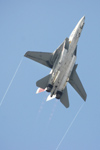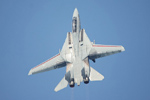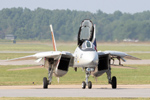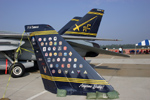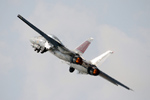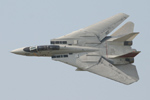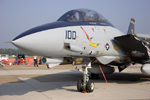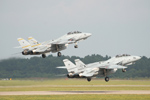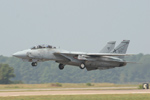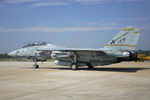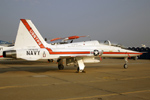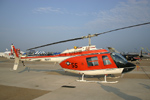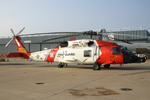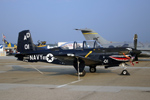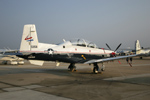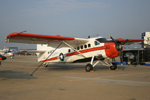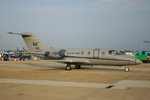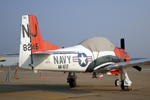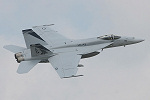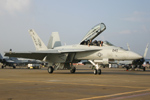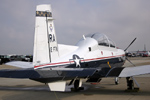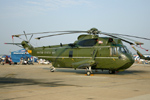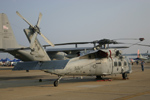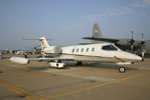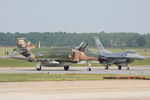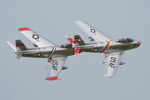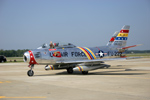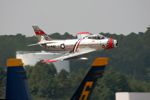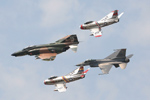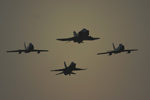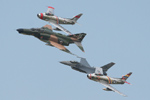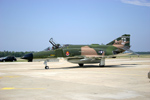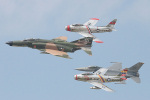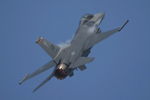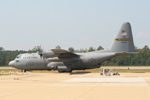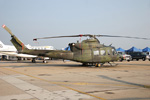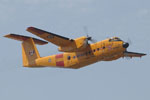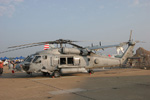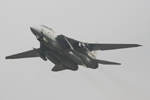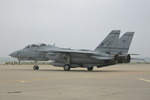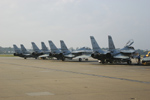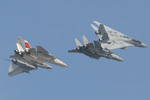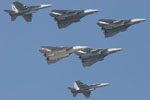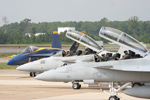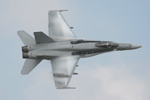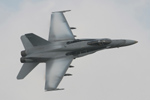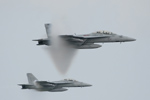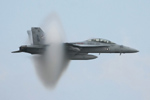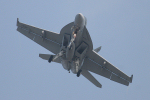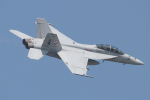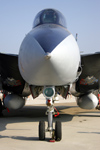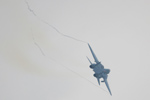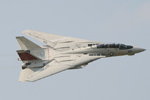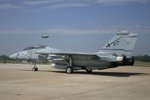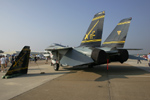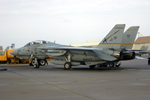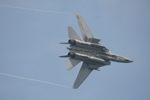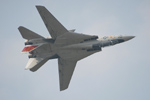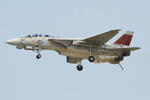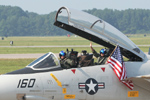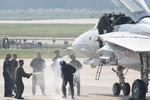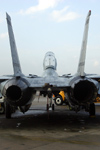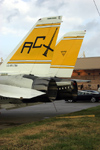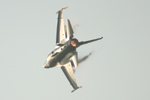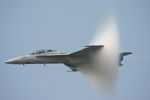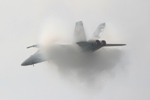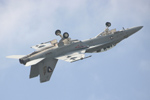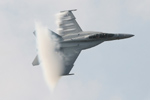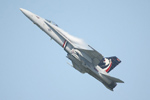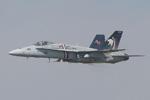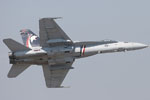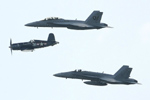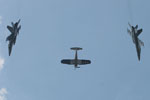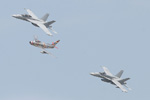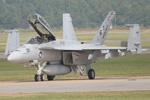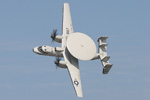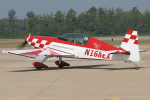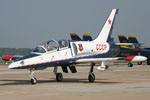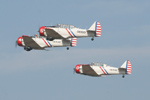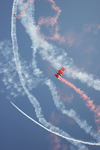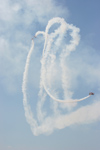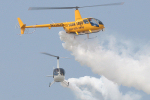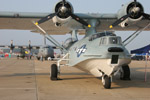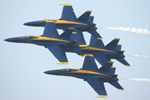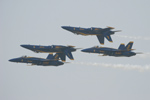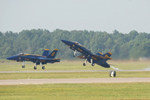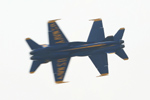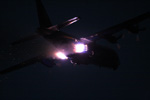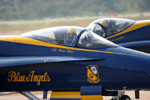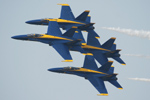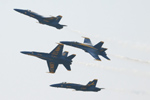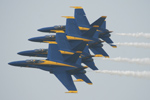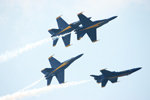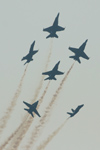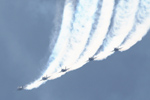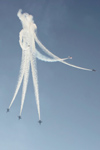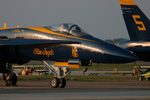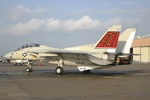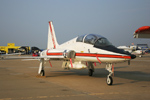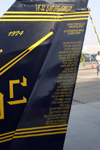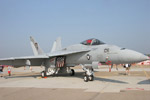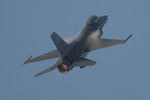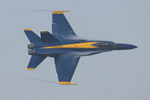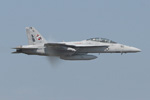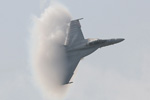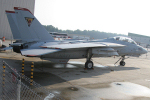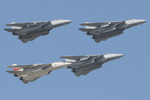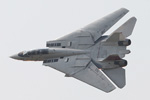
 |
|||||
| Author:
Robin Powney Photography: Paul Tiller and author |
|||||
This
article was first published on Air-Scene. |
|||||
|
Considering its status as the east coast’s sole Master Jet Base and home to all the USNs East Coast fighter and strike-fighter squadrons under COMNAVAIRLANT, it was fitting for the last ever USN F-14 tacdemo to be performed in the skies of Virginia. It is not an assumption too far if you were to assume that enthusiasts flocked to NAS Oceana for just the Tomcat – especially a flying one. It was noticed that enthusiasts had come from the UK, Japan, Poland, Australia and Brazil – to name just a few. I’m sure that if there had been passport control on the gates, “us foreigners” would have made up quite a high percentage of the 260,000 stong crowd. During the build-up to the show, rumours throughout the year varied from “diamond six” formations to not seeing any Tomcats at all and back again… blood pressures were going up and down and deep breaths were taken. When CDR Richard Erie and his airshow team confirmed the F-14 in the show, sighs of relief would have been heard the world over. |
||||
|
VF-32s
“retro jet” (the yellow tailed example) didn’t make
it into the show, but it was parked on the ramp with the other display
aircraft as a spare for the display jet and is now sat baking in the
sun at AMARC.
In terms of the static, the actual turn out was quite low but a few things spring immediately to mind here. Hurricane Ophelia. No-one seemed to really know which way Ophelia would move and sending your jets and helicopters to an area you don’t know won’t have a hurricane is a little daft. Unless of course you are a Hurricane Hunter, then right through the eye wall is normally in the job description! No-one can blame the organisers for a thinner than expected turnout. |
Tomcats.
Flying. The static is thus surplus to requirements! I don’t think
many would have minded had there been no static at all, although many
took advantage of the ample shade and protection from the sun provided
by the parked aircraft.
Having
said that, there were a few very interesting items parked up on the
Strikefighter Town USA ramps. I, for one, had never seen any USNTPS
aircraft or any USCG helicopters so the presence of the T-38A, U-6A
Beaver and the AS Elizabeth City HH-60J Jayhawk were more than welcome
in my book. I don’t know why, but the red & white colour schemes
of both the USNTPS and USCG just look right irrespective of what the
aircraft is. Olive drab HH-60s look, well, drab whilst their red/white
Coast Guard cousins, look fantastic! |
|
|
The
attendance of a 403rd Wg WC-130H was also somewhat of a surprise –
what with their home base of Keesler AFB being recently hit by Hurricane
Katrina and the demand placed upon the Hurricane Hunters by the NHC
and NOAA in what is turning out to be quite a busy hurricane season.
Sadly the home-unit static was a little thin with the only Oceana based
jets on static being the VF-32 F-14B ‘CAG bird’ and a VFA-106
F/A-18E – with fourteen VFA units and the Strike Fighter Weapons
School Atlantic (SFWSL) calling Oceana home, it is a shame more jets
couldn’t have been made available but we can’t have everything
and I was told most aircraft were hangared due to no-one knowing what
Ophelia would do (bear in mind the Virginia Beach coast region was still
under hurricane and tropical storm warnings until just before the show).
The Fighting Omars of VFC-12 were officially on deployment, to be curtailed
by Hurricane Rita, so they wouldn’t have been able to attend the
show anyway. |
As
a bonus, we did get to see a handful of VFA-143 Pukin’ Dogs (being
politically correct, they’re the Dogs) F/A-18E Super Hornets leave
mid-morning on Saturday and then again Sunday for carrier qualifications
with the USS John F. Kennedy prior to their prior to their upcoming
deployment aboard USS Dwight D. Eisenhower - their first cruise with
the F/A-18E after losing their last Cats in March. The carrier qualification
task was originally assigned to the USS Harry S. Truman before it was
ordered into the Gulf of Mexico and it saw VAW-120, VFA-106, VFA-143
and VFA-81 qualify 58 pilots after amassing 951 arrested landings. Four
VT squadrons and their T-45 Goshawks actually meant the total number
of arrested landings during the CARQUALs stood at 1,528. A good number
of VFA-11 Red Rippers Super Hornets, their last F-14 being retired in
April, were also at Oceana although most were hangared for the duration
of the show. |
|
|
Rotary
wise, the USN was represented by an example of the MH-60S Knighthawk,
from HSC-26 Chargers, which just so happened to be the same one as that
which was aboard the USS Saipan at the International Fleet Review, an
HH-60H Seahawk, a very smart looking UH-3H from HC-2 Fleet Angels at
Norfolk, one TH-57 Sea Ranger and, being used as the drop ship (making
it the first time I’ve ever seen anyone jump from a helicopter!!)
for the US and UK parachute teams on Sunday was an MH-53E Sea Dragon
presumably from HM-14 Vanguards at Norfolk. USAF attendance was limited
to the F-16 ‘Viper’ East Coast Demo Team from the 20th FW
at Shaw AFB, an immaculately turned out QF-4E Phantom drone in a superb
pale-bellied South East Asia camo scheme (one of the six drones the
USAF have saved from the ravages of an AIM-120 and painted up for their
new additional “heritage” role), a grey T-1A Jayhawk from
Vance AFB, an AFRC B-52H, a T-6 Texan II and a C-5B Galaxy plus the
two F-86 Sabres in USAF markings. Oh, and a rather large triangular
shaped bomber made a fleeting but welcome visit. |
These
two Sabres, in a glorious polished finish were to put on a very spirited
pairs routine with Dale “Snort” Snodgrass (the most experienced
F-14 pilot on the planet with more than 4,800 hours logged and owner
of a CV that lists the previous command of the entire Tomcat community
when PACFLT and LANTFLT Tomcat units were brought under the one command)
and Ed Shipley at the helms – both don’t seem to have any
understanding of what the term “low” actually means. This
pairs routine wasn’t just superbly flown and a pleasure to watch,
it was also the first time a Sabre duo had performed at an airshow for
the best part of 35 years. Both these guys, more specifically, magicians,
are to Sabres what Ray Hanna is to a Spitfire – although Snort
seemed to take his jet just that tad bit lower than I’ve seen
an aircraft ever go before. They get that low that the tails of a Hornet
become cover and something for them to hide behind. The routine was
akin to the P-51 duo at Duxford earlier this year and almost as if they
were welded together! |
|
|
The
F-4, F-86 pair and F-16 then formed up for the ACC Heritage Flight display
– at RIAT, a lot of people slated the choice of Dwayne O’Briens
“We Remember” track being played when the P-51/F-15C heritage
flight was displaying but as far as the fourship heritage flight at
Oceana was concerned, it actually sounded very good and almost moving.
At UK shows, crossing the crowdline is positively frowned upon (has
it got the death penalty yet?) but at Oceana, the heritage flight (amongst
many others) flew over the crowd more than once. The B-2A, the Spirit
of Texas, was only on Saturday’s programme and made a single flat-pass
down the display line, banked left back round to a point north of crowd
centre and then banked right for departure. It did make a change to
see a B-2 without a gaggle of F-15s shepherding it though although it
was still lacking something. |
As
far as the US Army goes, it was a particularly poor turnout, with only
the Army Special Ops Command Black Daggers parachute team being there
– a shame that we didn’t get any Army helicopters. However,
with the aid operation in Louisiana and the massive commitment of more
than 250 helicopters to that (including forty USN SH-60s and USAr UH-60s
flying ninety missions per day from the USS Harry S. Truman), it is
little wonder helicopters were thin on the ground. Almost conspicuous
by their absence were the Marines Corps. Not one example of any of their
toys made it on the ramps or into the air – being fair, Marine
Prowlers are in massive demand (in fact, as VMAQ-4 Seahawks left Al
Asad AB in July, VMAQ-1 Banshees took over) alongside their Navy and
joint USN/USAF Prowler colleagues, various Marine attack squadrons are
involved in continuing operations in Iraq and east coast fast jet or
helicopter units that were ‘home’ wouldn’t have wanted
to send any aircraft into the potential path of a hurricane. Furthermore,
as the US DoD fiscal year starts on October 1st, many units may not
have had the budget to send aircraft even if they’d wanted to. |
|
|
The
Canadian forces were represented by a CH-146 Griffon (basically a Huey
by another name), the rotary workhorse of the RCAF and a CP-140 Aurora
– although visually very similar to the P-3 Orion, the Aurora
has, mission-wise, more in common with the S-3 Viking and is due to
continue to serve the RCAF until 2025. I was also secretly hoping that
the CF-188 demo would have been able make it back to Oceana after displaying
there last year but ‘twas not to be! So, considering the circumstances
and commitments of the US DoD all over the world (and at home) the static
wasn’t that bad and it was better than nothing at all. Typical
of US shows, none of the aircraft had barriers and “posing shots”
seemed the order of the day for the crowd – fine for the taxpayer
who wants to touch what ‘they’ pay for, but not much use
for photography when it gets busy! The aircraft were well separated
though, so given a lack of people, clear shots with little to no obstructions
were a possibility. For those that ‘moan’ about UK shows
and their barriers, well, at least we can get shots without people! |
However,
all this pales into insignificance when you consider why most enthusiasts
went to Oceana. It wouldn’t have mattered if CDR Richard Erie
and his team had managed to secure the participation of a flying saucer,
maybe even a display by one – enthusiasts were there for the Tomcat.
The show doesn’t just mark the sombre occasion of the last ever
demo by the F-14, it also marks the occasion of the first time your
scribe ever got to see a Tomcat fly! Not just one mind, oh no, a handful!!
Four Turkeys were in the fleet flyby and airpower demo and then there
was the solo in the tacdemo. |
|
|
The
fleet flyby is truly a sight to behold – three VF-32 F-14Bs, one
VF-101 F-14D, two VFA-136 F/A-18Cs and two VFA-211 F/A-18Fs in a vee
formation with the Tomcats in a diamond at the point of the vee. These
same aircraft then go on to give the airfield a thorough seeing to in
the airpower demonstration. Rich’s Incredible Pyro are on hand
to set up simulated explosions from the bomb and strafe attacks when
the aircraft pass over head and it makes UK “airfield attacks”
look like they’re playing at it! The two F/A-18Cs, flown by Killer
and Sh8, were first up to step to the oche to go toe-to-toe with the
enemy prior to bugging out back to the carrier and letting the Fighting
Checkmates of Chum, Sonic, Taint and Cheech in their new Super Hornets
take the reigns. |
Saturday’s
weather allowed for the full “pop-up” bombing demo with
Sunday’s early haze limiting heights somewhat… but it was
just that tad more humid on Sunday, so when it came to the pair of Rhinos
steaming in from the left, vapour was bubbling off like it has gone
out of fashion. I’ve always wanted a shot of the “Hornet
shockcone” and VFA-211 allowed me to get that on one jet AND a
cone forming on the second jet in the background! Great stuff!! F/A-18F
– exit stage right. Not before Goon and Didja, in a VFA-106 F/A-18F,
took everyone by surprise with a “sneak pass” though. Think
low. Think fast. Then put the two together and don’t tell the
crowd… I was ready for it on Sunday though! |
|
|
Once
the Super Hornets had left the area, in came the muscle that only the
Tomcat can provide and boy, what muscle! Strafe runs, bombs, you name
it, the Swordsmen did it! For the next six months, the Tomcat retains
the title of the Navy’s premier precision strike aircraft (LGB
wise, it’s probably the premier precision strike jet, even beating
the F-15E, thanks to its T3 LANTIRN system) and that’s easy to
believe based on the airpower demo! VF-32s Vinny, Norm, Larry, Newg,
Smoov and Bus plus VF-101s Crash and one or two other Reapers RIOs certainly
did their best to show off the Tomcat to the massed crowd (although,
strangely, it was VERY quiet, crowd-wise, on Sunday morning) for the
last time. |
The
whole spectacle is fantastic – such a distinctive sound, well
OK, growl, from the most powerful engines ever fitted to a USN fighter
and no matter what it does, it looks like it’s doing it quickly.
If there’s a finer looking Navy jet, I haven’t seen it!
LT Jack “Rocco” Tangredi and LT Joseph “Smokin’
Joe” Ruzicka (incidentally, this crew were the display crew for
2004) did the Tomcat community proud with their two tacdemos over the
weekend. I felt Sunday’s display marginally edged out the Saturday
display but I could be basing this on the fact that the Sunday display
was done with the VF-101 retro jet whereas the Saturday display was
done with a VF-32 line jet. |
|
|
The
Tomcat doesn’t tend to create the same visual effects, vapour
wise, as the new kid on the block (or even the legacy Hornet for that
matter) but, being honest, who cares - I’d go as far as saying
that it was the finest fast jet demo I’ve seen in the last two
years. At 14:52 on September 18th 2005, it was all over and following
the end of the display on Sunday, Rocco and Smokin’ Joe were treated
to a drenching from their Tomcat colleagues. It brings the US Navy one
step closer to losing the Tomcat for good and Northrop-Grumman one step
closer to losing their dominance of the Carrier Strike Group (the F-14,
E-2 and EA-6B are all Grumman masterpieces – although they are
Boeing’s principal subcontractor for the Hornets so Grumman won’t
be leaving the carrier deck anytime soon). On the Monday after the show,
AD-160 was flown one last time to its final resting place at Castle
Air Museum in the San Joaquin Valley, CA, where it will, following a
rumour to the contrary, retain its VF-101 retro scheme. AC-115, one
of VF-32s jets, left Oceana for its last flight, flown by LT Brian “Beke”
Hodges and LT Ashley “Ciao” Augostini, on October 4th and
now calls the MAPS Air Museum at Akron-Canton Airport in Ohio its home.
|
Just
two days later, AC-101 left Oceana for the very last time when it headed
550 miles west to the Aviation Museum of Kentucky in Lexington. Four
more are currently under the control of Titan Systems’ SARDIP
program at Oceana and are soon to become shreds of metal in a Chesapeake
scrapyard. November 1st sees VF-32 officially become an F/A-18F Super
Hornet unit with the accompanying name change to VFA-32. Since the show,
rumours have been floating round about Snort buying between ten and
sixteen Tomcats to form a display team which will then choose from four
jets prepared for flight at any one time – this would be fantastic
news for the Tomcat legacy but whatever happens, Oceana 2005 did see
the last ever USN F-14 tacdemo. |
|
Unlike
last year when VFA-122 had the honours of being the USNs sole Rhino
demo unit, VFA-106 have joined the fray as the East Coast Demo Team
(Lemoore-based VFA-122 are the West Coast Demo Team and the West Coast
F/A-18E/F Fleet Replacement Squadron; on the east coast, VFA-106 train
all Hornet crews be they Legacy or Super types whereas on the west coast,
VFA-122 are the Super Hornet FRS and VFA-125 are the Legacy Hornet FRS)
and they’ve obviously taken on board some of the impressive tricks
in Ricardo Traven’s routine – including the tremendous take-off-into-roll
that Traven wowed RIAT and Farnborough crowds with in 2004. The major
difference is where Traven has a fully loaded jet in order to show off
on behalf of Boeing, the USN teams fly with clean jets. LT Sean “Knuckles”
Price and LT Charles “Ox” Shamonsky got the job of throwing
the Rhino about the sky on Saturday with LT Ian “Goon” Burgoon
and LT Craig “Spank” Sidwell taking over for Sunday, with
both days demos being flown in a VFA-106 Gladiators F/A-18F. The Tomcat
just got the nod for the best display of the show although the VFA-106
demo is one fine display which exhibits the agility and power of the
Super Hornet with great ease; not to mention the fact that it shows
off the Rhino’s ability to make its own clouds! |
So
called "Legacy" Hornet units were not forgotten with very
spirited displays from VFA-106s Major Jerry "Buff" Estell
(one of only three Marine instructor pilots on VFA-106) on Friday and
Sunday and Lt Dustin "Tupak" Lee on Saturday - both using
a VFA-131 Wildcats F/A-18C decked out in an extremely smart full colour
"CAG" scheme. Tupak had the better weather on Saturday which
allowed the full display to be flown whereas Buff's displays were hindered
by slightly poorer weather on Friday and Saturday which meant he had
to do the flat show. Whilst not quite as highly energetic as the Rhino
display, it is nevertheless a very well conducted display and, in my
opinion, it has the edge over the Hornet displays by the Swiss and Spanish
(I can't comment on the Finnish F-18C display at RIAT '05 as I wasn't
there). Some claim the European displays to be much better - I would
disagree with that; one thing the European operators probably won't
ever manage to pull off though is a colourful operational Hornet that
can match the USN CAG jets. Compared to a boring grey jet, the USNs
use of eyecatching CAG birds adds to the spectacle. |
|
|
On
the subject of Legacies, like the USAF with their Heritage Flight, the
USN have a “Legacy Flight” which used to include the F-14
but is now an F/A-18C, F/A-18E/F and a suitable warbird. Saturday saw
this warbird being an F4U Corsair, with Mr Snodgrass at the controls,
whereas Sunday saw the warbird being one of the F-86s which the commentator
claimed was to masquerade as an FJ-3 Sea Fury (with no mention of the
fact that the F4U had gone ‘tech’). Our own RAF could perhaps
learn a thing or two about these historic flights as they do look good
and the crowd seemed to love every minute of Oceana’s two heritage
displays – Typhoon F.2 with Spitfire anyone? |
Perhaps
the most surprising display of the lot was the E-2C+ Hawkeye –
ever seen an AEW platform produce wing-tip vortices in a turn? No, well,
Oceana’s crowds did! I really didn’t know the E-2 was that
agile - the display was very impressive for such an aircraft. The Hawkeyes,
complete with the new NP2000 8-bladed propellers, responsible for the
two displays were from VAW-120 Greyhawks (the sole E-2C / C-2A Fleet
Replacement Squadron, responsible for training all LANTFLT and PACFLT
Hawkeye and Greyhound personnel) at NAS Norfolk on the morning of their
displays and didn’t stay overnight at Oceana – which is
perhaps just as well really as the base got hammered by a large storm
on Saturday night and it took many Navy personnel working at 3am in
the morning under the intense thunderstorm (the lightning was more like
a strobe!) to get fences and tents back up again for the show on Sunday.
Sadly, Hawkeyes didn’t feature in the static park. |
|
|
Civilian
acts featured strongly in the lineup, including the mighty Shockwave
jet truck – when asked what you could do with three ex-Buckeye
engines, don’t say “strap them to a truck”…
it’s already been done - and done well too. 300mph comes up on
the speedo in roughly 11 seconds and top-end is 376mph – all thanks
to 18,000lbs of thrust; the engines are pointed up at a slight angle
to help make sure Kent Shockley doesn’t become an astronaut though.
This thing is truly mesmerizing to watch - especially the full act with
the additional aerobatic aircraft and the “game of chicken”.
It does however get a tad warm when Shockwave trundles past with the
three engines doing a good impression of a flamestack on an oilrig. |
Nancy
Lynn’s display, in an Extra 300L, is a typical aerobatic display
with maneuvers that you think would clearly make someone ill but what
makes the act unique is that Nancy’s sixteen year old son does
the commentary – making the act the only mother-son act in the
airshow world. The constant “give it up, my mom!”
comments in the Saturday commentary became a bit tedious as the display
went on and it seemed to drag on for longer than a display from say
Will Curtis or Denny Dobson would have done; just when you assumed the
display was over, Nancy would launch into more aerobatics. Impressive
maneuvers, yes, but a Tomcat it ain’t! The Red Baron Pizza Squadron
team of four Stearmans (all built sometime between 1941 and 1943 and
now with modified engines which provide twice the power of the original
engines and allow inverted flight), with eight pilots all having more
than 2000 hours to choose from, put on quite an admirable “formation
barnstorming” display although, being honest, they weren’t
really my cup of tea and I don’t think they made me want to go
and find the pizza outlets. To the teams credit though, they are the
longest running non-military airshow act in history as they’ve
been displaying at airshows for 31 years. |
|
|
The
only helicopter team in the US, the Showcopters, also displayed –
and though I wasn’t expecting a great deal, after all, Robinson
R44s aren’t exactly the best looking helicopters around, but I
was somewhat wrong… and the demonstration of “auto-rotation”
was impressive although the Royal Navy’s Black Cats Lynx pair
have nothing to fear. Jim Leroy’s Bulldog was another display
I wasn’t particularly bothered about (hey, I went for Tomcats!)
although it was a fantastic display, especially considering the tiny
size of the Pitts S2S and the massive runway of Oceana. At UK shows
such as RIAT and Waddington, small aircraft are often lost in the mass
of sky available to them but for some reason, the extra 2,000ft of runway
available at Oceana didn’t make the slightest bit of difference
and the small aircraft seemed to be more “in yer face” than
at RIAT. |
As
one would expect at a Navy airshow, the Blue Angels (or, giving them
their full title, The United States Navy Flight Demonstration Squadron)
were the closing item on the Saturday and Sunday. Having only seen them
once before, way back in 1992 at RAF Finningley, I was just looking
forward to watching them on their home turf and in decent weather. Their
mission is to impress potential Navy and Marines recruits and based
on what the crowds were doing when it was time for the Blues to display,
well, they’re doing something right. Cheering, shouting, arm waving,
you name it, the crowds were doing it – they seem proud of their
Navy’s display team. Quite understandably I suppose. |
|
|
This
show also marked the first time I’ve seen a Fat Albert JATO display
– phenomenal is the only word I can think of. The C-130T, marked
up with Marines titling showing off the dual USN/USMC nature of the
Blues (and in fact, crewed by an all Marine crew and the only Marine
aircraft permanently assigned to a Navy unit), looks fantastic in the
blue, yellow and white scheme and it only gets better when the eight
rockets on the rear fuselage of the Hercules are lit! Think of a typical
C-130 “Khe Sahn” approach in terms of the angles involved
and Fat Albert can do it the opposite way round – i.e. going up.
Takeoff is now just completed in less than 1,500ft, swiftly followed
by a 45º climb to finally level off at 1,500ft in just a matter
of seconds. It looked better during Friday night’s twilight show
thanks to it being dark but doing it in daylight is almost as good and
at least it makes photography just that little easier. |
Blues
1 through 4 are the first into the air in a diamond formation leaving
5 and 6 on the piano keys, a formation loop later and Blues 5 and 6
depart in spectacular fashion. After a short takeoff roll, #5 pulls
up sharply leaving #6 to continue down the runway at only a few feet
AGL. Right down the other end of the runway, #6 is stood on its tail
and goes upwards. Vapour comes off the LERXs of this pair on their take
off like it would on a Hornet doing a tight turn during a display –
fantastic! In keeping with their reputation for getting up close to
each others jets, the display itself was flown with very little aircraft
separation in the formation maneuvers and aside from the odd gaps, it
was a joy to watch – even if photography in the late afternoon
was a bit of a pain due to where the sun was. Seemingly taking a leaf
out of VFA-106s book, one jet came from nowhere and pulled off another
of these darn sneak passes – very impressive but a swine to try
to catch in a photo when you’re not expecting it. |
|
|
The
twilight show, following on from the Friday practice, brings another
dimension to the show – parachute teams jump with ‘spark
generators’ instead of smoke canisters strapped to their ankles,
Shockwave could do a fine job as a lighthouse replacement and Fat Albert’s
JATO, well, the whole thing is one visual feast. I didn’t get
to see the fireworks show as the Oceana Officers Club was too much of
an attraction and the 29 hour day on Friday meant I didn’t even
bother with the “beach blast” (whereby a VFA-106 Super Hornet
made a few passes of Virginia Beach’s oceanfront with the burners
on) on Saturday night so I retired to the hotel for some much needed
sleep. |
In
terms of the weekend show days, we left Virginia Beach at 7:30-7:40ish
and were parked up by 8ish so traffic going in wasn’t a problem.
Maybe it was the fact that we stayed quite late but getting out wasn’t
much of a problem either – there appeared to be just the one exit,
which you’d think would create a problem, but the queue was continually
moving. All bags much larger than a compact camera case were subject
to search and the security personnel on the gates did an absolutely
fantastic job – extremely thorough but very quick… in less
than a minute, I had seen every pocket/holder in my bag searched and
even individual covers for various bits of photographic gadgetry were
opened and inspected. It was also reassuring to see regular security
patrols, most were dog patrols with dogs you probably wouldn’t
want to argue with, including the one wearing the sunshade! |
|
|
Like
most US shows, entrance was completely free but on Saturday, I took
advantage of the Executive Squadron Chalet and its free food and drink.
A front row, next-to-the-fence, seat was claimed and the free drinks
were perhaps the only thing that kept me alive to see Sunday –
the 95-100ºF heat and 95%+ humidity just about finished me (and
many others) off. Never before had I wanted a few clouds at an airshow
– here in the UK, the wish is for sunshine and cloudless skies!
In addition to the life-saving nature of the drinks the food was fantastic
and basically an “all you can eat” buffet. Without doubt,
this is THE way to do the show. |
Sunday
saw a decision made to get different angles on the shots so we, after
thinking long and hard about another day with free drinks in the ESC
(tickets are available on showdays), took up a top row position in one
of the bleachers further down the crowdline. If you have no idea what
a bleacher is, it’s basically a folding ‘grandstand’
and the kind you often see on TV at US sporting events. The downside
to this is food and drink isn’t “on tap” - you have
to pay for it and walk further to fetch it. Food was good quality, with
a great selection (including stalls catering for pretty much any diet)
at agreeable prices and ice cold water and soft drinks were readily
available. |
|
Would
I go back? You bet I would!! It was quite possibly the best show I’ve
ever been to. |
I
would like to take time to thank the following people for their help
and assistance: CDR Richard “Corky” Erie, LCDR Norm Concho,
Troy Snead, JO3 Amanda Robinson, LT Brian “Beke” Hodges,
LTjg Jay “MJ” Consalvi, Maj Jerry "Buff" Estell. |

